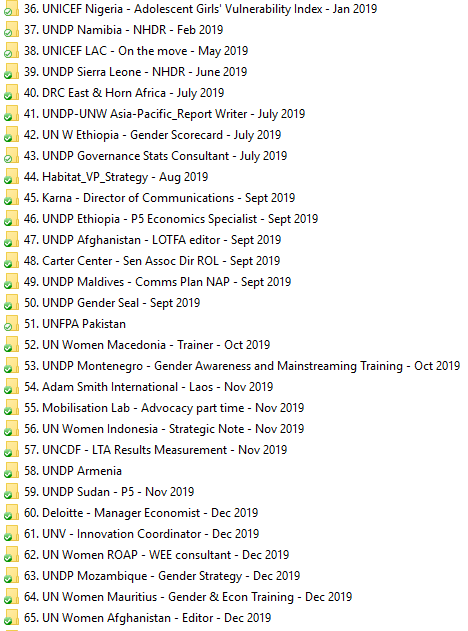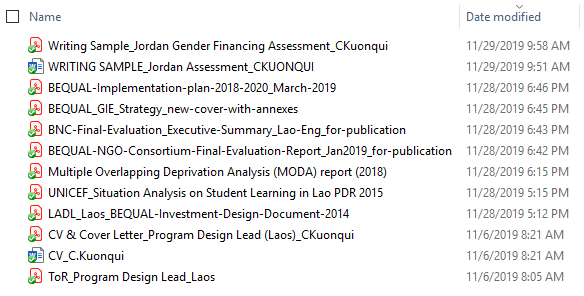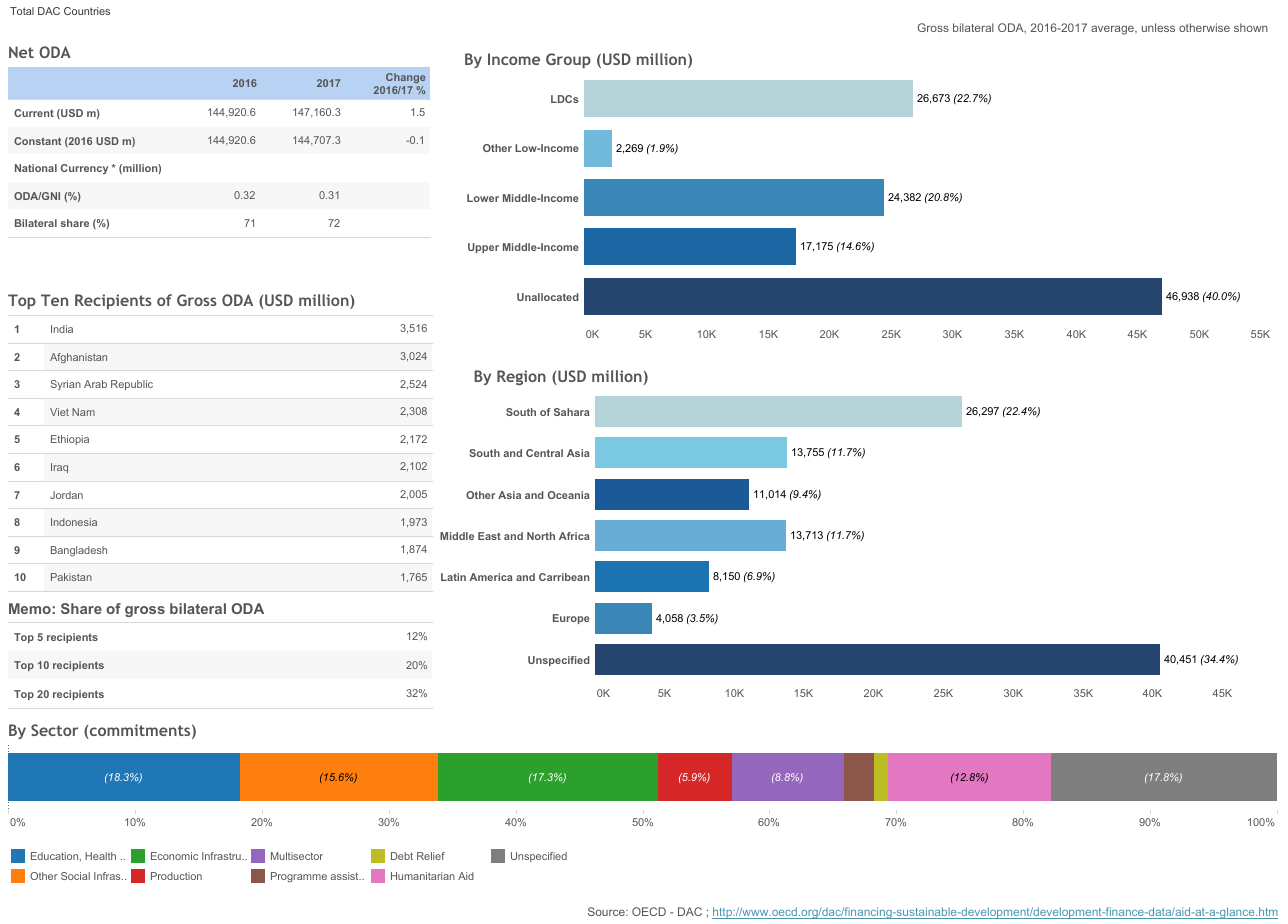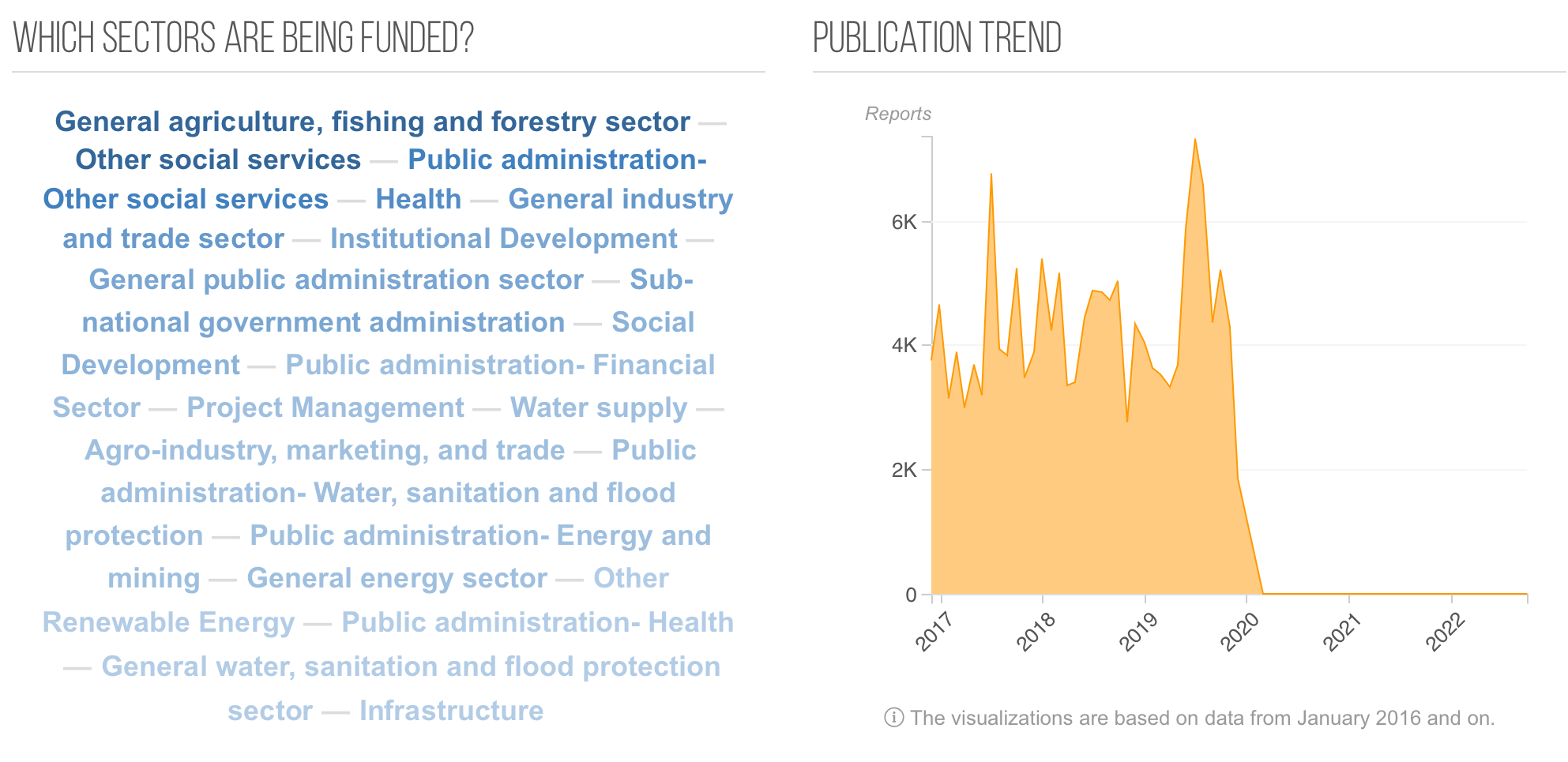There are lies, damn lies, and statistics.
We often “feel” like certain trends happen to us.
But when we look at the hard data – do they actually play out?
Let’s find out.
Do you know your personal job statistics?
You see, in 2019 – I applied to exactly 30 jobs.
I keep the lights on in my house by doing consulting work.
This is exactly what my job application system looks like….

If you don’t already, I recommend you use a similar job tracking system.
I track every organization, country, job title and month of application. (By the way, the folder numbering goes back about 3 years ago when I started using this specific tracking system.)
In each folder, I keep track of:
- The job description
- My tailored CV
- My tailored Cover Letter
- Any technical or financial proposal required
- And any research documents I’ve looked at
Here’s what that looks like:

So what’s the verdict?
In the early part of the year, I got 1 job without applying to it. The power of networking paid off – as a previous client referred me to this assignment.
Over the following months, I didn’t see many opportunities that fit what I could do. This made the 2nd quarter of the year go dry for me. I’ll come back to this later.
It wasn’t until September that I started submitting more applications.
Around then, I got another job I didn’t apply for that I’m completing right now. Again: through the magic of networking, as a colleague who had been offered the job couldn’t take it – he then recommended me to do it.
Now, don’t be fooled.
Networking IS important. It can open many doors. But I didn’t actually know the people hiring me in the least. And my CV and background that I carefully crafted and tailored to their interests and goals also clearly impressed them.
If you can’t prove you fit on paper or in the interview, it doesn’t matter how great your networking is – your prospects will always be dim. But when you can make both work, boom: job. I show you the ins and outs to all this in my flagship program, Break Into Development.
Now back to the stats…
Of the roles I recently submitted applications for, I’ve done 2 interviews in the last couple of weeks. On the latest one, I haven’t heard back yet.
On the other, I was informed that I scored “almost maximum” on the ratings, meaning I scored the highest on the technical evaluation. (Know how to tell if you did your thing on the interview? Every question after the 1st starts with… “Well, you already answered this with what you said earlier, but maybe you can say more about…” Definitely a sign you’re on the right path to standing out.)
So I scored almost maximum. And they wanted to work with me.
But I didn’t get the offer.
Wait, what?
I didn’t get this job for 3 important reasons you should pay attention to:
- My financial offer, why not high overall, was relatively higher than the 2nd best candidate. Even though I was technically better qualified, the 2nd-tier candidate won the job because they were cheaper.
- As many of you know, I am Ecuadorian-American. But very clearly American in my style and accent. The 2nd candidate was from within that region and they thought it would be better to give them the opportunity.
- Finally, the carbon footprint! This was the first time hearing this, but in some ways it’s good. The recruiting team observed that I would be traveling from my home-base in the United States, or roughly 30,000 km to cause A LOT of per capita carbon emissions. The 2nd candidate, being from within the region, would not have to travel as far and thus, their carbon footprint and environmental impact would be less.
Seriously, this all happened.
And how do I know? Because I sent a well-worded email asking for feedback. I know too few of you do this, so you better get started doing so. As you can see, it can be invaluable for your career.
Now on 2 of these, there is nothing I can really do. That was how the cookie crumbled.
But the 3rd reason I lost the job to the 2nd-tier candidate?
You better be sure I looked into how to offset carbon footprint due to air travel. And my job applications, where necessary, now carry the phrase:
“As a social enterprise, ZeroPoverty Solutions [that’s the name of my consulting company] offsets the carbon emissions due to air travel for its staff.”
By the way, I was offered a job as I prepared this article in a record timing, 2 weeks from the date of application to the contract date.
I wasn’t even interviewed for this one, which still surprises me. The first thing I heard was when my references were being contacted.
How I won that job deserves its own detailed posting, but the bottom-line is I used the trends I discuss below and other research tools to craft an application that positioned myself, well… apparently strongly enough, to get an offer without an interview.
What the trend means
My personal data tell me things tightened in global development in the last 6 months. Assignments I was winning became much harder to win. The competition may not be better in technical terms. But there is a race to the bottom on funding. I took some licks, but drew what lessons I could. I share them with you now.
Other anecdotal evidence from friends and colleagues around the world appears to confirm this. Just as I was finishing this email to you, I learned a friend of a friend working on gender issues in Asia is also having a difficult time finding work.
But remember… there are lies, damn lies, and statistics.
We must continue on our journey to understand the trends—because they WILL make or break your career.
Now, what do the aid and jobs data say?
Here are the most recently available aid flows, for the 2016-2017 period:

There is a lot to breakdown in this. I show you how to think through a number of the major trends in my flagship program, Break Into Development, so you can turn this kind of information into usable and actionable insights for your career growth.
But here are few take-aways:
- In 2017, ODA (official development assistance, a key acronym you should know!) combined for a total of: US$ 147 billion. That is the total number of actual aid that goes around the world.
- Compared to the previous year, that represented a DECREASE in funding of -0.1%, in adjusted dollar terms. (Where my economists at? You know that’s what matters in the trend.)
- So money is going down, if only slightly.
Take note of where the funding is going, both in terms of geography and sectors. This can tell you about donor interests.
For instance, Education, Health and other Social Services receive the largest donor funding commitments.
And countries including India, Afghanistan or regions like Sub-Saharan Africa receive the largest overall shares of official development aid.
Like in much else in life, you should ‘follow the money’ in making your career choices. I encourage you to do your own analysis of these trends and see how they can influence your understanding of your job situation today.
While this is the latest official data available, it is current only as of 2017.
For more recent data, I turned to a different source.
And that data tells a different story? Well, maybe…
Here is the trend in the numbers of publication of new funding opportunities – those that provide jobs for folks like you and me.

What do you see?
First, the number of new funding publications in specific sectors can be of interest. Agriculture is getting a lot of attention these days.
But look at the publication trend on the right.
Do you see that spike somewhere around September 2019?
Nearly 7,000 new funding projects were published in the third quarter of this year. That represents a good bit more number of publications for projects than the previous high point in what looks like September 2017—more than 2 years back.
As I shared with you a few months ago…
There is an annual cycle to funding – which means there is an annual pattern for when new job opportunities open up.
You can see in this same chart that January starts off strong every year. But then opportunities drop off heavily.
Remember when I said I didn’t really find anything worth applying to in the 2nd quarter of 2019?
Well, that matches with fewer projects published in the overall trend.
Alright, so what does this all mean?
The latest official aid data seem to confirm a shrinking amount of total funding in the sector.
But the publications of new opportunities since September 2019 have increased significantly.
Now, there could be a situation that more, smaller funded opportunities are coming out. Or that we don’t have enough of a full picture just yet.
We may need to wait for the release of the 2018 and 2019 ODA statistics to get a better sense of where things may be heading.
But let’s not stop here just yet.
Let me bring in two more sources of data you should be aware of…
The UN can’t pay its staff?
In October 2019, the United Nations warned that they had a budget crisis: Member States owed US$ 1.3 billion in dues.
(International organizations like the UN are made up by countries or “Member States” – that commit and deliver a certain amount of funding according to their national or global interests. This funding then shapes the organization’s priorities—and the type and number of job openings for you.)
When countries don’t pay, there is no money for programming, policy development – or for the jobs that you and I do that deliver on this work.
The result has been that UN staff travel got cut back to almost zero. Many initiatives may still get shut down. And other cost saving measures being put into place.
You can expect these measures to reasonably include a shortage of staff or consulting opportunities.
Now, here’s a REALLY important job statistic…
In January 2019, Devex, the largest job portal in the global development sector, saw a 26% INCREASE in new job opportunities posted on its website.
They expect a similar large jump in jobs in the new year.
And with that recent spike in the number of new funding opportunities we say, I would say that an even larger increase in new jobs will be published soon.
A wave of new opportunity coming in January 2020
You should be aware of all these data, trends and patterns.
You can use them to guide your career growth in a number of ways:
- Following donor interest can tell you where to stay ahead of the competition.
- Remember yesterday when I said senior-level professionals know statistics off the cuff? Well I just gave you a bunch of new data that can impress in your next interview.
- The annual cycle of job postings is VERY important for your future prospects to break free from your current job. If you’re not careful, you can be caught off guard like I was in the 2nd quarter of this year—with a big drop in the number of opportunities, it was hard to even find interesting jobs to apply to.
But if you plan well in advance…
You can position your job search, networking, interviewing, CV and Cover Letter in just the right way to beat out the competition and SHOW hiring managers what you’re capable of bringing to their teams.
How can you use these trends to position yourself to find new work opportunities, learning and career growth in your future?
Let me know in the comments.